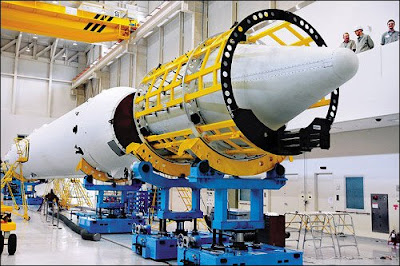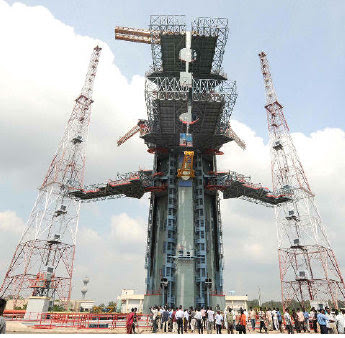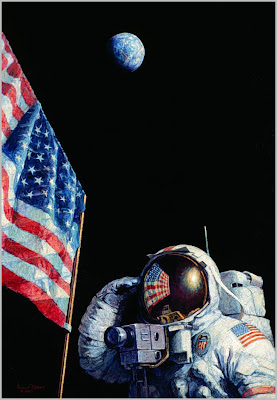In its fourteenth flight conducted from Satish Dhawan Space Centre (SDSC) SHAR, Sriharikota this morning (October 22, 2008), the Indian Space Research Organisation’s (ISRO’s) Polar Satellite Launch Vehicle, PSLV-C11, successfully launched the 1380 kg Chandrayaan-1 spacecraft into a transfer orbit with a perigee (nearest point to Earth) of 255 km and an apogee (farthest point to Earth) of 22,860 km, inclined at an angle of 17.9 deg to the equator.
After a 52 hour count down, PSLV-C11 lifted off from the Second Launch Pad at SDSC SHAR at 06:22 Hrs Indian Standard Time (IST) with the ignition of the core first stage. The important flight events included the separation of the first stage, ignition of the second stage, separation of the payload fairing at about 116 km altitude after the vehicle had cleared the dense atmosphere, second stage separation, third stage ignition, third stage separation, fourth stage ignition and fourth stage cut-off.
PSLV-C11 is the uprated version of ISRO’s Polar Satellite Launch Vehicle in its standard configuration. Weighing 320 tonnes at lift-off, the vehicle uses larger strap-on motors (PSOM-XL) to achieve higher payload capability. PSOM-XL uses 12 tonnes of solid propellants instead of 9 tonnes used in the earlier configuration of PSLV. PSLV is a four stage launch vehicle employing both solid and liquid propulsion stages. PSLV is the trusted workhorse launch Vehicle of ISRO. During 1993-2008 period, PSLV had fourteen launches of which thirteen (including today’s launch) are consecutively successful. PSLV has repeatedly proved its reliability and versatility by launching 30 spacecraft (14 Indian and 16 for international customers) into a variety of orbits so far.
Vikram Sarabhai Space Centre (VSSC), Thiruvananthapuram, designed and developed PSLV. ISRO Inertial Systems Unit (IISU) at Thiruvananthapuram developed the inertial systems. The Liquid Propulsion Systems Centre (LPSC), also at Thiruvananthapuram, developed the liquid propulsion stages for the second and fourth stages of PSLV as well as reaction control systems. SDSC SHAR processed the solid propellant motors and carried out launch operations. ISRO Telemetry, Tracking and Command Network (ISTRAC) provided telemetry, tracking and command support.
Chandrayaan-1 is India’s first spacecraft mission beyond Earth’s orbit. It aims to further expand our knowledge about Earth’s only natural satellite – the moon. With well-defined objectives, Chandrayaan-1 mission intends to put an unmanned spacecraft into an orbit around the moon and to perform remote sensing of our nearest celestial neighbour for about two years using eleven scientific instruments built in India and five other countries.
The primary objectives of Chandrayaan-1 are:
To place an unmanned spacecraft in an orbit around the moon
To conduct mineralogical and chemical mapping of the lunar surface
To upgrade the technological base in the country
Chandrayaan-1 aims to achieve these well-defined objectives through high-resolution remote sensing of moon in the visible, near infrared, microwave and X-ray regions of the electromagnetic spectrum. With this, preparation of a 3-dimensional atlas of the lunar surface and chemical and mineralogical mapping of entire lunar surface is envisaged.
PSLV placed the Chandrayaan-1 spacecraft into a highly elliptical Transfer Orbit (TO) around the earth. Later, through a series of highly complex manoeuvres, the desired trajectories will be achieved. After circling the Earth in its Transfer Orbit, Chandrayaan-1 spacecraft will be taken into more elliptical ‘Extended Transfer Orbits’ by repeatedly firing its Liquid Apogee Motor (LAM) in a pr-determined sequence. Subsequently, the LAM is again fired to make the spacecraft to travel to the vicinity of the moon.
When it reaches the vicinity of the Moon and passes at a few hundred kilometers from it, its LAM is fired again so that the spacecraft slows down sufficiently to enable the gravity of the moon to capture it into an elliptical orbit.
Following this, the height of the spacecraft’s orbit around the moon is reduced in steps. After a careful and detailed observation of the orbit perturbations there, the orbital height of Chandrayaan-1 will be finally lowered to its intended 100 km height from the lunar surface. Moon Impact Probe will be ejected from Chandrayaan-1 spacecraft at the earliest opportunity to hit the lunar surface in a chosen area.
Later, cameras and other scientific instruments are turned ON and thoroughly tested. This leads to the operational phase of the mission. This phase lasts for about two years during which Chandrayaan-1 spacecraft explores the lunar surface with its array of instruments that includes cameras, spectrometers and SAR.
The Payloads: There are 11 payloads (scientific instruments) through which Chandrayaan-1 intends to achieve its scientific objectives.
They include five instruments designed and developed in India, three instruments from European Space Agency (one of which is developed jointly with India and the other with Indian contribution), one from Bulgaria and two from the United States.
The Indian payloads of Chandrayaan-1 are:
Terrain Mapping Camera (TMC), a CCD camera that maps the topography of the moon, which helps in better understanding of the lunar evolution process.
Hyperspectral Imager (HySI), another CCD camera, is designed for mapping of the minerals on the lunar surface as well as for understanding the mineralogical composition of Moon’s interior.
Lunar Laser Ranging Instrument (LLRI) provides necessary data for accurately determining the height of lunar surface features.
High Energy X-ray Spectrometer (HEX) is designed to help explore the possibility of identifying Polar Regions covered by thick water-ice deposits as well as in identifying regions of high Uranium and Thorium concentrations.
Moon Impact Probe (MIP) demonstrates the technologies required for landing a probe at the desired location on the moon. It is also intended to qualify some of the technologies related to future soft landing missions.
The six international payloads of Chandrayaan-1 are:
Chandrayaan-1 Imaging X ray Spectrometer (C1XS), an ESA payload and jointly developed by Rutherford Appleton Laboratory of England and ISRO Satellite Centre, Bangalore, intends is to carry out high quality mapping of the moon using X-ray fluorescence technique for finding the presnce of Magnesium, Aluminium, Silicon, Iron and Titanium distributed over the surface of the Moon.
Smart Near Infrared Spectrometer (SIR-2), another ESA payload, developed by Max Plank Institute of Germany, aims to study the lunar surface to explore the mineral resources and the formation of its surface features.
Sub kiloelectronvolt Atom Reflecting Analyser (SAR), the third payload from ESA, is built by Swedish Institute of Space Physics and Space Physics Laboratory of Vikram Sarabhai Space Centre, Tiruvananthapuram. The aim of this instrument is to study the surface composition of the moon and the magnetic anomalies associated with the surface of the moon.
Radiation Dose Monitor (RADOM), a payload developed by Bulgarian Academy of Sciences, aims to characterise the radiation environment in a region of space surrounding the moon.
Mini Synthetic Aperture Radar (MiniSAR) is one of the two scientific instruments from the USA and is from Johns Hopkins University’s Applied Physics Laboratory and Naval Air Warfare Centre, USA through NASA. MiniSAR is mainly intended for detecting water ice in the permanently shadowed regions of the lunar poles up to a depth of a few meters.
Moon Mineralogy Mapper (M3) is an imaging spectrometer from Brown University and Jet Propulsion Laboratory of the US through NASA, is intended to assess and map lunar mineral resources at high spatial and spectral resolution.
The Spacecraft: Chandrayaan-1 spacecraft weighed about 1380 kg at the time of its launch and is a 1.5 m cuboid with a solar panel projecting from one of its sides. The spacecraft is powered by a single solar panel generating electrical power of 700 W. A Lithium ion battery supplies power when the solar panel is not illuminated by the sun. To make Chandrayaan-1 spacecraft to travel towards the Moon, its Liquid Apogee Motor (LAM) is used. Liquid propellants needed for LAM as well as thrusters are stored onboard the spacecraft. Chandrayaan-1 spacecraft’s Dual Gimballed Antenna transmits the scientific data gathered by its eleven scientific instruments to Earth.
Chandrayaan-1 spacecraft was built at ISRO Satellite Centre, Bangalore with contributions from Vikram Sarabhai Space Centre (VSSC), Liquid Propulsion Systems Centre (LPSC) and ISRO Inertial Systems Unit (IISU) at Tiruvananthapuram, Space Applications Centre (SAC) and Physical Research Laboratory (PRL), Ahmedabad and Laboratory for Electro-optic Systems (LEOS), Bangalore.
The Ground Segment: The Ground facilities of Chandrayaan-1 perform the important task of receiving the health information as well as the scientific data from the spacecraft. It also transmits the radio commands to be sent to the spacecraft during all the phases of its mission. Besides, it processes and stores the scientific data sent by Chandrayaan-1 spacecraft.
ISRO Telemetry, Tracking and Command Network (ISTRAC) had a lead role in establishing the Ground Segment of Chandrayaan-1 with contributions from ISAC and SAC. The Ground Segment of Chandrayaan-1 consists of:
Indian Deep Space Network (IDSN)
Spacecraft Control Centre (SCC)
Indian Space Science Data Centre (ISSDC)
The Indian Deep Space Network receives the data sent by the Chandrayaan-1 spacecraft. Besides, it sends commands to the spacecraft at a power level of upto 20 kilowatts. IDSN consists of two large parabolic antennas – one with 18 m diameter and the other 32 m diameter – at Byalalu, situated at a distance of about 35 km from Bangalore. Of these the 32 m antenna with its ‘seven mirror beam waveguide system’, was indigenously designed, developed, built, installed, tested and qualified. The 18 m antenna can support Chandrayaan-1 mission, but the 32m antenna can support spacecraft missions well beyond Moon.
The Spacecraft Control Centre, located near the ISTRAC campus at Peenya, North of Bangalore, is the focal point of all the operational activities of Chandrayaan-1 during all the phases of the mission.
The Indian Space Science Data Centre forms the third element of Chandrayaan-1 ground segment. Also located at Byalalu, ISSDC receives data from IDSN as well as other external stations that support Chandrayaan-1, stores, processes, archives, retrieves and distributes scientific data sent by Chandrayaan-1 payloads to the user agencies.
 NASA's Lunar Chariot sports concept pressurized crew cabin, looking more and more like the vision the agency had for Earth to Moon to Mars architecture before President Nixon and Congress committed to the Space Shuttle and cancelled Apollo missions 18, 19 and 20 in 1972.
NASA's Lunar Chariot sports concept pressurized crew cabin, looking more and more like the vision the agency had for Earth to Moon to Mars architecture before President Nixon and Congress committed to the Space Shuttle and cancelled Apollo missions 18, 19 and 20 in 1972.





















